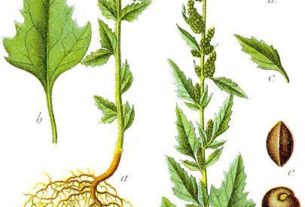The consumption of a variety of leafy greens in Mexico goes back to pre-Hispanic times, when the gathering of wild plants was necessary to supplement the food provided by hunting wild animals. Before the Spaniards came, there was very little animal husbandry and the diet was heavily vegetarian, especially among the poorer people. Quelites and quintoniles were among the most widely consumed wild greens, as were the leafy vines and flowers of cultivated vegetables such as squash, chayote and beans. Traveling around the country and shopping in different regional markets shows that this is still the case in many areas.
Greens, both cultivated and gathered, play an important role in areas where meat is considered a luxury. Even when meat is used, it is in smaller amounts, often cooked with greens that add flavor and nutrition, besides extending the meal.
Greens are, in fact, most often cooked rather than eaten raw, with the exception of the salads that are increasingly served in urban restaurants and homes. The trend toward green salads in the modern Mexican diet is a healthy one, and public service announcements and signs remind people to disinfect raw greens before eating them.
With the rainy season upon us here in Mexico, a profusion of wild greens, gathered by indigenous women in the sierra for home cooking and for sale, appears in local markets alongside the cultivated ones. The following list, separate from the seasoning and medicinal herbs previously discussed in this column, contains the most common leafy greens used in soups, stews and salads in different parts of Mexico. They contain vitamins C and A, riboflavin (B2), calcium, potassium and iron, as well as being good sources of fiber. Many of these greens, including the wild ones, are found in several parts of the world, and the recipes below provide some ideas for adding a tasty Mexican touch to healthy eating.
Acelgas: chard ( Beta vulgaris cycla ) Originally from the Mediterranean basin, and now found all over the world, chard is one of the most popular greens in Mexico and is found in nearly all markets in the country year round. Unlike its cousin, the beet, chard is grown for its leaves rather than the root. In Mexican cooking, the leaves are sometimes stuffed with meat or cooked with rice, and a standard everyday dish is a tomato-based broth with chard and fideos (thin noodles.)
Berros: watercress ( Nasturtium officinalis ) Found in temperate regions throughout the world, watercress has long been valued as both a food and medicinal plant, rich in iodine, iron and potassium. In northern and central Mexico, a licuado of watercress is taken as a remedy for renal and pulmonary problems. In cooking, Mexican chefs often combine watercress with potatoes in a variety of ways, or make crema de berros, a cream soup. Watercress salad is commonly found on menus featuring nouvelle Mexican cuisine.
Espinacas: spinach ( Spinacea oleracea ) A good source of iron, spinach is second only to liver as a source of folic acid, making it an ideal choice for pregnant women and others requiring a healthy intake of folic acid without the high cholesterol content of liver. In Mexico, it is used in soups, creamed, sautéed with onion and garlic, and makes a fine, mousse-like dish called pastel de espinacas.
Guías: vines The vines and leaves of several varieties of squash, including calabacitas (zucchini) and chayote are used extensively in Mexico as soup greens. Sopa de guías — squash vine soup — is a well-known Oaxacan favorite, especially during the rainy season.
Hojas de betabeles: beet greens ( Beta vulgaris rubra ) Although grown primarily for its edible enlarged root, the greens of this herbaceous plant are also used for cooking in Mexico, especially in the countryside, where nothing is wasted.
Huazontle: ( Chenopodium nuttalliae, Chenopodium berlandieri ) Sometimes called “Aztec spinach”, this native Mexican plant actually resembles an elongated version of broccoli, although it is more closely related to amaranth. Stuffed with cheese, batter fried and served in a pasilla chile sauce, huazontles are one of the most appreciated greens in Mexico.
Lechuga: lettuce ( Lactuca sativa ) All lettuce varieties have been cultivated from the original wild varieties found in North America, including Mexico, as well as in Northern Europe and North Africa. Its Latin name is derived from Lactus, meaning milk, because of the milky white sap found in the stems. In Mexico, lettuce has primarily been used as a garnish for corn-based dishes such as tostadas, though recently, different salad varieties are found in more mercados and supermarkets, especially lechuga orejona (romaine) and lechuga sangria (red leaf lettuce).
Quelites: lamb’s quarters ( Chenopodium album ) Although the name quelites is used in the countryside for a variety of wild greens, true quelites are lamb’s quarters, found throughout Mexico and gathered in abundance during the rainy season. Lamb’s quarters is an Old World green, naturalized extensively in North America and used as a pot herb. In some areas of Mexico, notably the Sierra Norte of Puebla, quelites are used in a wide variety of recipes.
Quintoniles: amaranth greens ( Amaranthus hypochondriachus ) Amaranth leaves, as well as the seeds, represented a significant portion of the pre-Hispanic diet in Mexico. The seeds, high in the amino acid lysine, are used today in the candy called alegrías, in moles, in soups, and as a cereal. The greens are put to use in soups, salads and guisados — stews.
Romeritos ( Suaeda mexicana ) During Lent in Mexico, the indigenous romerito leaves are combined with chiles, and sometimes with mole paste, to flavor a broth for the egg and dried shrimp patties known as tortitas de camarón. They are also sautéed with onions and garlic, as well as being batter fried.
Verdolagas: purslane ( Portulaca oleracea ) A European herb naturalized throughout Mexico and southern California, verdolagas are found in central Mexican markets during most of the year. They are especially appreciated in the classic dish puerco con verdolagas, in which they are cooked in a salsa verde with pork.
- Ensalada de Berros con Espinacas: Mexican Style Watercress and Spinach Salad
- Sopa de Fideos con Acelgas: Swiss Chard Noodle Soup
- Quelites con Frijoles: Lamb’s Quarters with Beans
- Quintoniles con Rajas: Amaranth Greens with Poblano Chile Strips



a Mayan woman fed us Chaya twice in the Yucatan. They pick it wild.